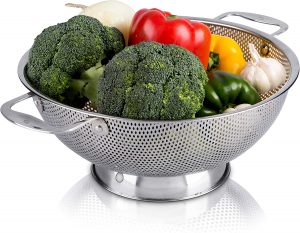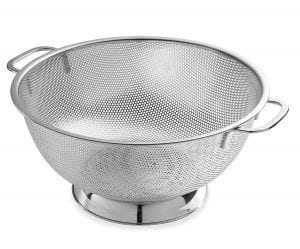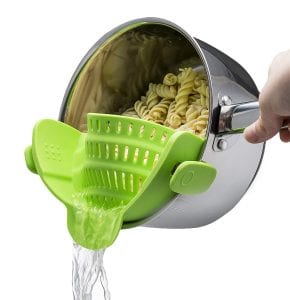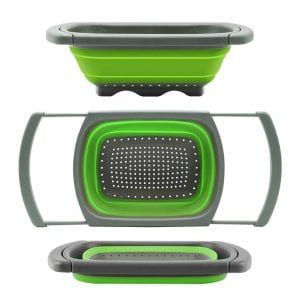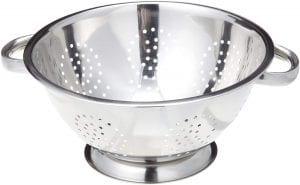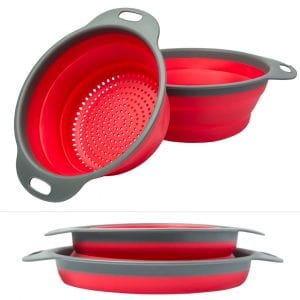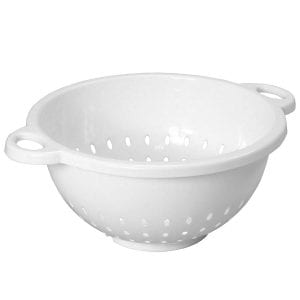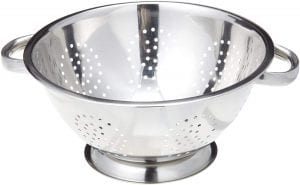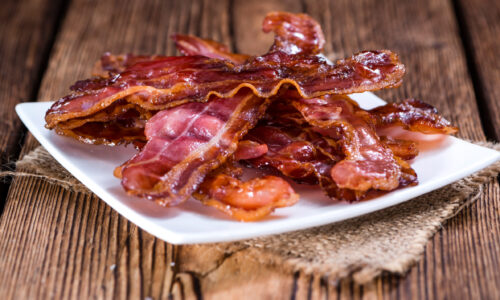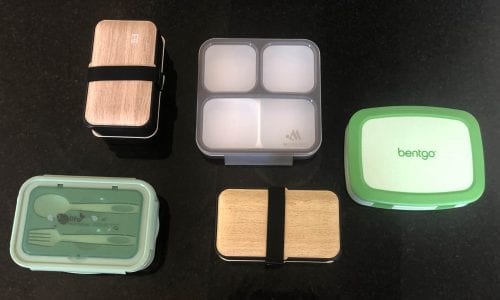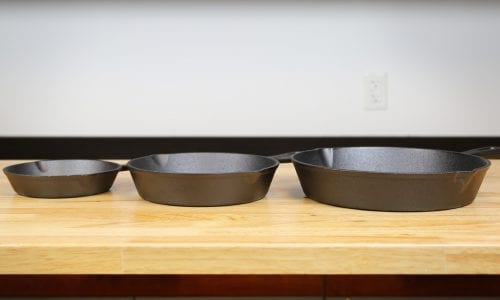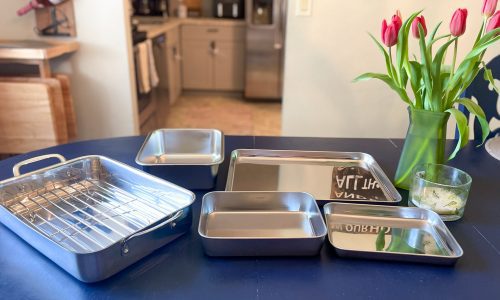The Best Colanders
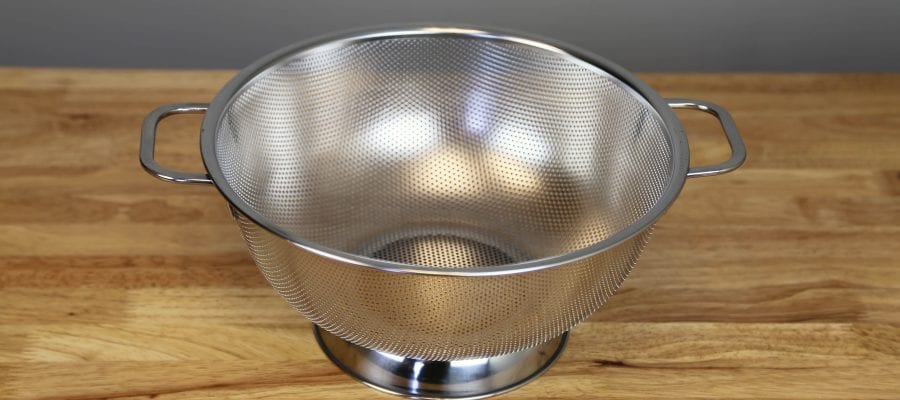
Our Review Process
Don't Waste Your Money is focused on helping you make the best purchasing decision. Our team of experts spends hundreds of hours analyzing, testing, and researching products so you don't have to. Learn more.
Our Picks For The Top Colanders
The small holes on this colander set are nearly as effective as mesh at straining smaller foods, but are less subject to clogging. The pores drain very quickly, and the handles are made of the same sturdy stainless steel as the body. The entire colander is rust-proof and safe for dishwashers.
Quick-Straining AccessoryTiny pores and solid construction make this colander set a kitchen staple.
This strainer's stainless steel construction fends off rust and wear. Easy-grip handles prevent drops. Your rice and spaghetti will stay in place thanks to hundreds of closely-spaced holes. During our testing, we found this strainer to be sturdy, and it fit well in the sink.
Quality MaterialsThe Bellemain Colander is a well-made strainer that will last for years.
This BPA-free silicone colander clips onto almost any sized pot or pan for rapid straining. It's small, but holds up to heavier foods. It's also dishwasher safe and takes up less room than a traditional strainer. In our testing, we love that this strainer allowed us to reserve some water in the pot. We also loved how small and easy to clean it was.
Space SavingThe Kitchen Gizmo Strainer is clip-on silicone strainer that's great for smaller kitchens.
Buying Guide
Your favorite pantry staples, like pasta and rice, cook up quick and add a tasty starch to any dish. But you’ve got to have the right tools to whip up a great bowl of rotini or a side of brown rice. Colanders, sometimes called strainers, are a kitchen essential that don’t get a lot of attention. However, you need a high-quality one to whip up your favorite dishes.
You can pick up a cheap plastic colander at any major retailer or home goods store for a couple of bucks, but it won’t last, and plastic can absorb strong odors over time. A more thoughtful approach to purchasing this kitchen standby will pay off in the long run.
Colanders are perforated bowls that you use to drain or rinse foods like spaghetti, quinoa or chopped veggies. They typically have a long handle or a grip on each side so that you can grab and tilt the colander without burning your hands. The terms “colander” and “strainer” are often used interchangeably, but some people prefer to use “strainer” for cookware with small perforations and “colander” for larger holes.
Some colanders are built with a base or small legs on the bottom. This elevates the strainer so you can rest it in your kitchen sink as it drains, preventing the strained water from building up and seeping back into the bowl. Other colanders have wide hooks so you can rest them on the side of your sink as you strain heavy foods.
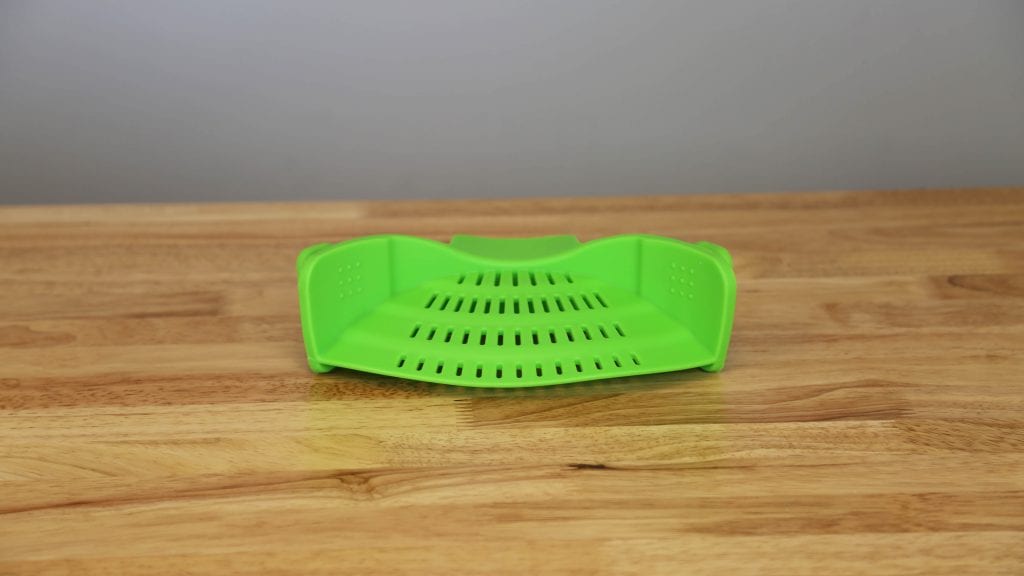
Clip-on colanders are also a popular option. They’re usually made of silicone, and they can stretch or retract to fit on almost any pot or pan. Some stainless steel clip-on colanders exist, but they’re not as adjustable as silicone versions. Clip-ons are smaller than standard colanders, so they’re great for small kitchens with limited storage space.
Buying a quality colander or strainer instead of settling for cheaply made ones is a small change that can yield big results. Our Tips & Advice will help you navigate your online shopping.
What to Look For
- The perfect colander or strainer will be made of dense, rust-proof materials, like stainless steel. Silicone strainers are also a great option. They’re less likely to create a breeding ground for bacteria than other materials. Plastic colanders may crack or absorb odors over time.
- Think about what types of meals you frequently cook. This will determine the size of the holes you’ll need in your strainer. If you make lots of rice or quinoa, look for a strainer with very small holes. Models with double layers of mesh are also helpful; they’ll keep small grains in your strainer while still draining water. If you love thicker pastas like spaghetti, a colander with larger holes will suffice.
- The placement of the handle or grips on your colander is also important. Handles should be long enough to keep your hands safely away from hot water. They also need to be sturdy enough to hold up under the weight of thicker veggies like potatoes. If your colander uses hand grips, make sure they stick out far enough to give you some distance from boiling water. Grips with rubber covers will also keep your palms nice and cool as you cook.
- Do you have a large kitchen, or are you whipping up meals in a small space? Your colander will take up some room in your cabinet, so make sure you have enough room for storage before you buy a large one. Strainer sets will take up more space, while folding silicone colanders can squeeze into small corners. You can also use the colander’s grips or hooks to hang it up, saving yourself tons of cabinet space.
- Properly caring for your strainer will help it last for years. Make sure that yours is dishwasher safe before you pop it in on the hot cycle. Handwashing it with gentle dishwashing liquid and allowing it to air dry is always a safe bet. Using your sink’s sprayer hose on the colander’s basket will help you knock any food particles loose.
- If you need different-sized colanders for a variety of food sizes to strain, consider purchasing a colander set to get the best bang for your buck.
More to Explore
Colanders are far more than vessels for draining your spaghetti. They’re also part of a social movement called Pastafarianism.\
Pastafarianism is also called The Church of the Flying Spaghetti Monster, and it all started in 2005 with a satirical open letter penned by activist Bobby Henderson. Henderson, a physics graduate, was appalled when the Kansas State Board of Education decided to allow public schools to teach Intelligent Design (a form of Creationism) as an alternative to evolution in science classes.
Henderson demanded that if schools were going to teach Intelligent Design in science classrooms, they should give equal time to teaching kids about The Flying Spaghetti Monster. He invented the creature as a parody god to drive home his point that Intelligent Design wasn’t scientific, and therefore, his imaginary googly-eyed creature deserved equal stage time.
The Spaghetti Monster quickly became an Internet sensation. Henderson’s book, “The Gospel of the Flying Spaghetti Monster,” was released in 2006. The parody religion’s core tenets claim that an invisible ball of spaghetti created the universe, and that global warming is caused by a decline in the number of pirates.
Colanders became the recognized headgear of Pastafarianism, and people across the globe still wear them as a political statement.

